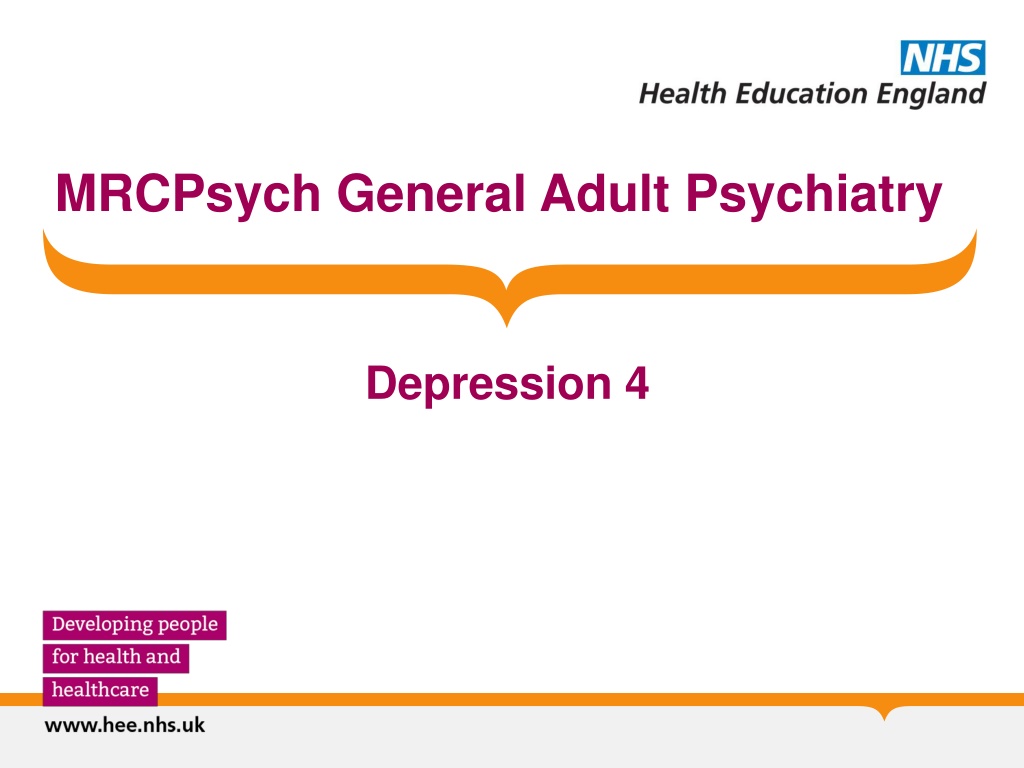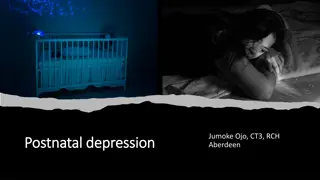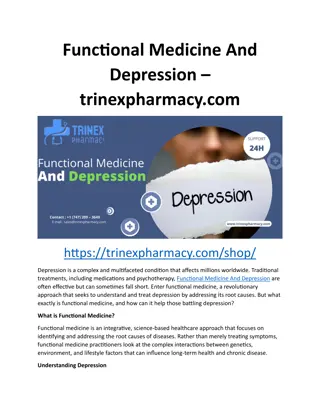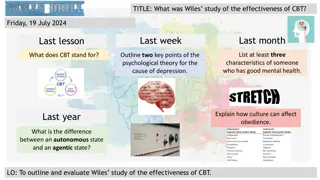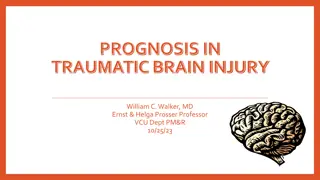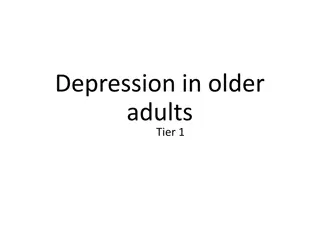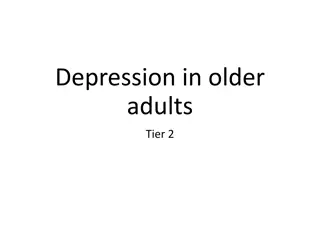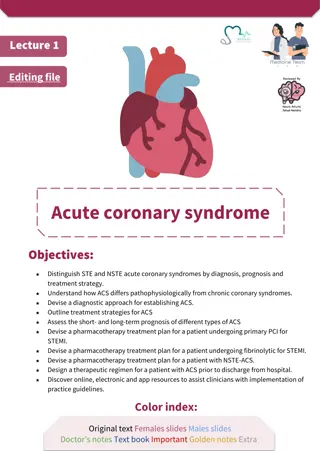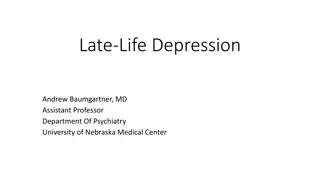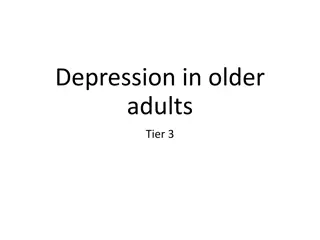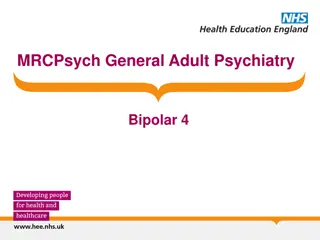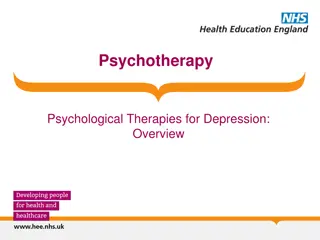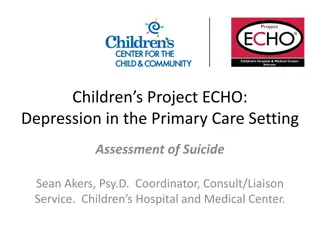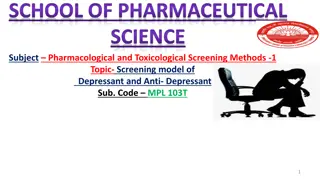The Course and Prognosis of Depression in Adults
Developing an understanding of the course and prognosis of depression is crucial for making informed treatment decisions, assessing risks for poor outcomes, and estimating social consequences. The onset of depression can occur at any time in life, with varying outcomes unique to each patient. Early identification of subclinical syndromes can help prevent the development of a full depressive episode. Episode length varies, with some becoming chronic, emphasizing the importance of tailored treatment approaches.
Download Presentation

Please find below an Image/Link to download the presentation.
The content on the website is provided AS IS for your information and personal use only. It may not be sold, licensed, or shared on other websites without obtaining consent from the author. Download presentation by click this link. If you encounter any issues during the download, it is possible that the publisher has removed the file from their server.
E N D
Presentation Transcript
MRCPsych General Adult Psychiatry Depression 4
Depression 4 Objectives To develop an understanding of: the course and prognosis of Depression. risk factors for poor outcomes.
Depression 4 Expert Led Session Depression: Course & Prognosis
Why is it important to understand the course of a condition? Helps decide whether to start long-term prophylactic medication whether to stop a successful long-term treatment estimating the social consequences and mortality A distinction should be made between the natural history, i.e its spontaneous untreated course and the course observed under treatment
Description of a course will include age of onset episode length recurrence of episodes and residual symptoms between episodes Outcomes This will be unique to each patient
Onset Depression may start at any time of life. A two-peak distribution of the age of onset has sometimes been described. But it is a continuum from early-onset to late-onset depression, with a systematic decrease in genetic vulnerability and an increase in precipitation by environmental factors. Late onset depression - often milder and morechronic - unlikely to be associated with personality disorder or substance misuse but can be associated with physical health
subclinical syndromes frequently precede major depression over many years Over 50% of patients this is especially true for depression in old age (75 years and more). Early identification and treatment can prevent the development of a full episode
Episode length Most depressive episodes are short, but a minority become chronic (lasting more than 2 years) In 10 to 20 per cent of subjects, mood disorders take a chronic course (length over 24 months) without remission. Some evidence suggests that the average length of an episode has not reduced over the years amidst the introduction of various antidepressants. (Wretham, 1929). Average length for a major depressive episode (Angst, 1995) among hospitalised patients 5-6 months 25 per cent of depressive episodes lasted more than 11 months. in the community, where many untreated cases of depression occur, episode duration was considerably shorter; the 25th, 50th, and 75th percentiles were 4 weeks, 12 weeks, and 30 weeks respectively
Recurrence Recurrence is typical of mood disorders. The course of the mood disorders, whether psychiatric inpatients, outpatients, or general practitioner patients, is recurrent (Angst, 1990) even milder depressive episodes tend to be recurrent Average number of episodes in a 20 year period is 5-6 It can be characterized by the number of episodes, the length of intervals (measured from remission to the onset of a new episode), and the length of cycles (measured from the beginning of one episode to the beginning of the next).
Recurrence Generally the time from the first to the second episode is on average much longer than that from the second to the third (Kessing, 1998) This progressive shortening of cycles and free intervals then levels off and fluctuates around a certain (but still variable) individual limit Progressive shortening of cycles Poor prognosis Cycle length tends to be shorter in late-onset than in early onset mood disorders increased risk of recurrence in the elderly
Recurrence Precipitating events play an important role in the onset of the first few affective episodes thereafter recurrence seems to become autonomous with stressful events. Precipitating events - increase a pre-existent vulnerability sensitising the patient - more vulnerable to further episodes kindling effect First put forward by Kraepelin Possibly due to culminative damage resulting in altered microenvironment with abnormal gene expression
Recurrence Pathological features associated with recurrent depression Cell loss in the subgenual prefrontal cortex (PFC) Cell trophy in the dorsolateral PFC and Orbitofrontal PFC Loss of hippocampal volume Neurochemical associated with recurrent depression Decreased levels of CREB, BDNF, and the TrkB receptor have been reported in suicide victims
Outcomes/Prognosis Remission after affective episodes is frequently incomplete. (Paykel, 1995) Residual symptoms are common in psychiatric and general practitioner patients Residual symptoms of major depression, defined by a score of 8 or more on the 17-item Hamilton Depression Scale, were found in 32 per cent of 60 patients, 12 to 15 months after remission Residual symptoms represent a strong risk factor for further recurrence (Paykel, 1995) a survival analysis found a threefold higher risk of in patients with residual symptoms (76% of patients) than in those with out residual symptoms (25% of patients)
Outcomes/Prognosis Lee and Murray re-examined depressive patients, most had originally been admitted to hospital After 10 years - roughly one-third had been readmitted After 20 years - about two-thirds had been readmitted Chronic residual symptoms are those typical of depression: mood, anxiety, genital symptoms, insomnia, headaches, neurasthenic complaints, reduced libido, and gastrointestinal symptoms Long-term antidepressants, should not be withdrawn until the patient has had at least 1 year completely free of symptoms.
Mortality The Standardised Mortality Ratio (SMR) is raised for patients with a history of depression in comparison to patients without a history of depression Suicide is the main cause of mortality Figures differ in studies average is about 5% Other causes of increased mortality cardiovascular disorders, cerebrovascular disorders, respiratory infections, thyroid disorders, and secondary substance abuse/dependence.
Prognosis Previous course of mood disorders predicts future course Recurrence predicts further recurrence Increased length of episodes and residual symptoms predict recurrence. Acute onset and few attacks predict a better outcome High-baseline neuroticism scores predict a poorer outcome in patients Comorbidity of alcoholism and personality disorders with depression make for a poorer prognosis and outcome of both
References Angst, J. (1990). Depression and anxiety: a review of studies in the community and primary health care. In Psychological disorders in general medical settings. pp. 60 8 Lee, A.S. and Murray, R.M. (1988). The long-term outcome of Maudsley depressives. British Journal of Psychiatry, 153, 741 51 M ssner, Rainald, et al. "Consensus paper of the WFSBP Task Force on Biological Markers: biological markers in depression." The World Journal of Biological Psychiatry 8.3 (2007): 141- 174. Angst, J. and Preisig, M. (1995) Course of a clinical cohort of unipolar, bipolar and schizoaffective patients. Results of a prospective study from 1959 to 1985. Schweizer Archiv f r Psychiatrie und Neurologie, 146, 5 16 Paykel, E.S., Ramana, R., Cooper, Z., Hayhurst, H., Kerr, J., and Barocka, A. (1995). Residual symptoms after partial remission: an important outcome in depression. Psychological Medicine, 25, 1171 80 Kessing, L.V., Andersen, P.K., Mortensen, P.B., and Bolwig, T.G. (1998) Recurrence in affective disorder. I. Case register study. British Journal of Psychiatry, 172, 23 8 Kraepelin E: Manic-Depressive Insanity and Paranoia. Translated by Barclay RM, edited by Robertson GM. Edinburgh, E & S Livingstone, 1921 Wertham, F.I. (1929). A group of benign chronic psychoses: prolonged manic excitements. With a statistical study of age, duration and frequency in 2000 manic attacks. American Journal of Psychiatry, 9, 17 28.
Depression 4 MCQs 1. In recurrent depression with a history of significant functional impairment, long-term antidepressants should not be withdrawn until what duration since complete remission: A. 3 months B. 6 months C. 1 year D. 2 years E. 3 years
Depression 4 MCQs 1. In recurrent depression with a history of significant functional impairment, long -term antidepressants should not be withdrawn until what duration since complete remission: A. 3 months B. 6 months C. 1 year D. 2 years E. 3 years
Depression 4 MCQs 2. Many risk factors have been identified in depressive disorder. Which ONE of the following statements regarding risk of developing depression is NOT true? A. Risk is increased if there is a first degree relative with bipolar affective disorder Risk is more increased in lower social classes than middle social classes following a life event Risk is increased by having poor social support Risk in single women doubles in the presence of poverty Risk is increased in females who are heterosexual compared to males who are homosexual B. C. D. E.
Depression 4 MCQs The correct answer is: E. Risk is increased in female heterosexuals compared to male homosexual Explanation: Higher risk of depression in the LBGTQ communities.
Select one: Select one: Select one: Vortioxetine Vortioxetine Vortioxetine Vortioxetine Vortioxetine Vortioxetine Vortioxetine Reboxitine Fluoxetine Mirtazapine Venlafaxine Venlafaxine Venlafaxine Venlafaxine Venlafaxine Reboxitine Fluoxetine Mirtazapine Mirtazapine Mirtazapine Mirtazapine Reboxitine Fluoxetine Fluoxetine Fluoxetine Reboxitine Reboxitine Depression 4 MCQs 3. Mrs. Jones is treated for breast cancer with Tamoxifen but is also depressed. Which of the following drugs is contraindicated in her situation? A. Vortioxetine B. Roboxetine C. Fluoxetine D. Mirtazapine E. Venlafaxine
Select one: Select one: Select one: Vortioxetine Vortioxetine Vortioxetine Vortioxetine Vortioxetine Vortioxetine Vortioxetine Reboxitine Fluoxetine Mirtazapine Venlafaxine Venlafaxine Venlafaxine Venlafaxine Venlafaxine Venlafaxine Venlafaxine Reboxitine Fluoxetine Mirtazapine Mirtazapine Mirtazapine Mirtazapine Mirtazapine Mirtazapine Reboxitine Fluoxetine Fluoxetine Fluoxetine Fluoxetine Fluoxetine Reboxitine Reboxitine Reboxitine Reboxitine Depression 4 MCQs The correct answer is: C. Fluoxetine In several studies (notably, Jin et al, 2005), concurrent use of tamoxifen with the potent CYP2D6-inhibitor antidepressants paroxetine and fluoxetine, was associated with a 65-75% reduction in circulating endoxifen (active metabolite of tamoxifen) levels in some women (especially in poor metabolisers). Explanation: Paroxetine and fluoxetine should not be prescribed for depression or hot flashes in women who have had breast cancer and are now taking tamoxifen to prevent a recurrence. Citalopram or venlafaxine should be considered instead. This message comes from a study showing that paroxetine, by interfering with the metabolism of tamoxifen, reduces or abolishes its protective effect against breast cancer recurrence, and that women taking both drugs have an increased risk for death from breast cancer. Paroxetine is a strong inhibitor of the CYP2D6 enzyme that converts tamoxifen to its active metabolite, reducing the amount of active drug that is released.
Depression - 4 MCQ 4. What is the approximate male : female ratio of completed suicide in England, Scotland and Wales? A. 7:1 B. 3:1 C. 5:1 D. 1:1 E. 2:1
Depression - 4 MCQ The correct answer is: 3:1 Explanation: male : female is 3:1
Depression 4 MCQs 5. The average duration of an untreated episode of depression: A. 3 years B. 1 year C. 6 months D. 3 months E. 1 month
Depression 4 MCQs 5. The average duration of an untreated episode of depression: A. 3 years B. 1 year C. 6 months D. 3 months E. 1 month
Any Questions? Thank you
